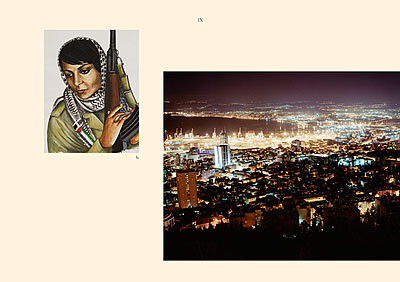Taryn Simon
21 Oct 2012 - 07 Jan 2013
TARYN SIMON
A Living Man Declared Dead and Other Chapters I-Xviii
21 October 2012 – 7 January 2013
The Museum of Contemporary Art, Los Angeles is the first U.S. museum to present the entirety of Taryn Simon’s (American, b. 1975) photographic project A Living Man Declared Dead and Other Chapters. This powerful, elaborately constructed photographic work was produced over a four-year period (2008-11), during which the artist travelled around the world researching and recording "bloodlines" and their related stories. In each of the "chapters" that make up the work, the external forces of territory, power, circumstance, or religion collide with the internal forces of psychological and physical inheritance. The subjects Simon documents include victims of genocide in Bosnia, test rabbits infected with a lethal disease in Australia, the first woman to hijack an aircraft, and the living dead in India. This exhibition at MOCA is organized by Rebecca Morse, Associate Curator, Museum of Contemporary Art, Los Angeles.
A Living Man Declared Dead and Other Chapters I–XVIII was produced between 2008 and 2011, during which the artist, Taryn Simon, traveled around the world researching and recording bloodlines and their related stories. In each of the eighteen “chapters” that make up the work, external forces such as territory, power, circumstance, and religion collide with the internal forces of psychological and physical inheritance. The subjects Simon documents include victims of genocide in Bosnia, test rabbits infected with a lethal disease in Australia, the first woman to hijack an aircraft, and the “living dead” in India. Her collection is at once cohesive and arbitrary, mapping the relationships among chance, blood, and other components of fate.
Each work in A Living Man Declared Dead comprises three segments. On the left of each chapter are one or more large portrait panels systematically ordering a number of individuals directly related by blood. The sequence of portraits is structured to include the living ascendants and descendants of a single individual. The portraits are followed by a central text panel in which the artist constructs narratives and collects details. On the right are Simon’s “footnote images” representing fragmented pieces of the established narratives and providing photographic evidence. The empty portraits represent living members of a bloodline who could not be photographed. The reasons for these absences are stated in the text panels and include imprisonment, military service, dengue fever, and women’s refusals to be photographed for religious or social reasons.
Simon’s presentation explores the struggle to determine codes and patterns embedded in the narratives she documents, making them recognizable as variations (versions, renderings, adaptations) of archetypal episodes from the present, past, and future. In contrast to the methodical ordering of a bloodline, the central elements of the stories—violence, resilience, corruption, and survival—disorient the highly structured appearance of the work. A Living Man Declared Dead and Other Chapters highlights the space between text and image, absence and presence, and order and disorder.
A Living Man Declared Dead and Other Chapters I-Xviii
21 October 2012 – 7 January 2013
The Museum of Contemporary Art, Los Angeles is the first U.S. museum to present the entirety of Taryn Simon’s (American, b. 1975) photographic project A Living Man Declared Dead and Other Chapters. This powerful, elaborately constructed photographic work was produced over a four-year period (2008-11), during which the artist travelled around the world researching and recording "bloodlines" and their related stories. In each of the "chapters" that make up the work, the external forces of territory, power, circumstance, or religion collide with the internal forces of psychological and physical inheritance. The subjects Simon documents include victims of genocide in Bosnia, test rabbits infected with a lethal disease in Australia, the first woman to hijack an aircraft, and the living dead in India. This exhibition at MOCA is organized by Rebecca Morse, Associate Curator, Museum of Contemporary Art, Los Angeles.
A Living Man Declared Dead and Other Chapters I–XVIII was produced between 2008 and 2011, during which the artist, Taryn Simon, traveled around the world researching and recording bloodlines and their related stories. In each of the eighteen “chapters” that make up the work, external forces such as territory, power, circumstance, and religion collide with the internal forces of psychological and physical inheritance. The subjects Simon documents include victims of genocide in Bosnia, test rabbits infected with a lethal disease in Australia, the first woman to hijack an aircraft, and the “living dead” in India. Her collection is at once cohesive and arbitrary, mapping the relationships among chance, blood, and other components of fate.
Each work in A Living Man Declared Dead comprises three segments. On the left of each chapter are one or more large portrait panels systematically ordering a number of individuals directly related by blood. The sequence of portraits is structured to include the living ascendants and descendants of a single individual. The portraits are followed by a central text panel in which the artist constructs narratives and collects details. On the right are Simon’s “footnote images” representing fragmented pieces of the established narratives and providing photographic evidence. The empty portraits represent living members of a bloodline who could not be photographed. The reasons for these absences are stated in the text panels and include imprisonment, military service, dengue fever, and women’s refusals to be photographed for religious or social reasons.
Simon’s presentation explores the struggle to determine codes and patterns embedded in the narratives she documents, making them recognizable as variations (versions, renderings, adaptations) of archetypal episodes from the present, past, and future. In contrast to the methodical ordering of a bloodline, the central elements of the stories—violence, resilience, corruption, and survival—disorient the highly structured appearance of the work. A Living Man Declared Dead and Other Chapters highlights the space between text and image, absence and presence, and order and disorder.

